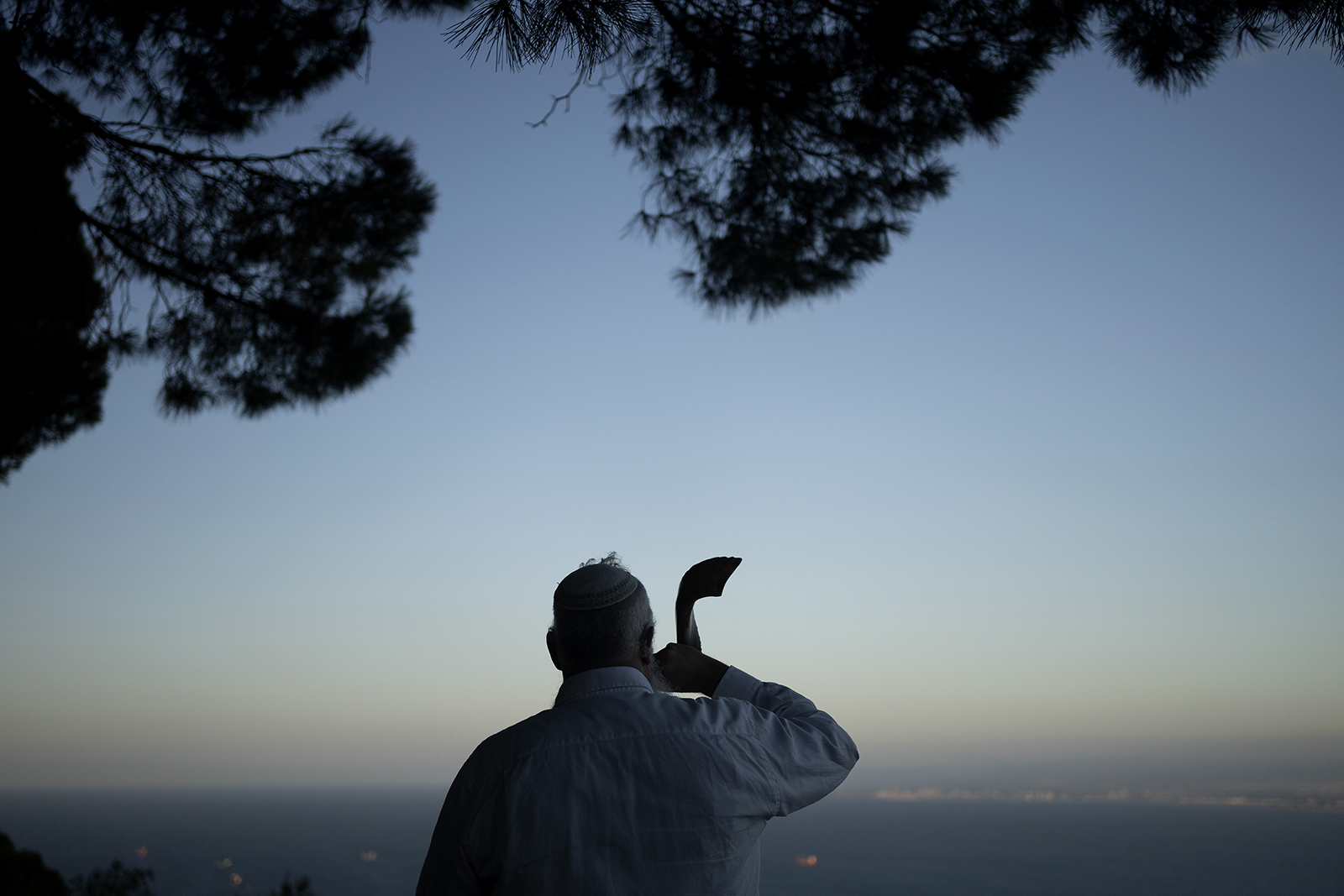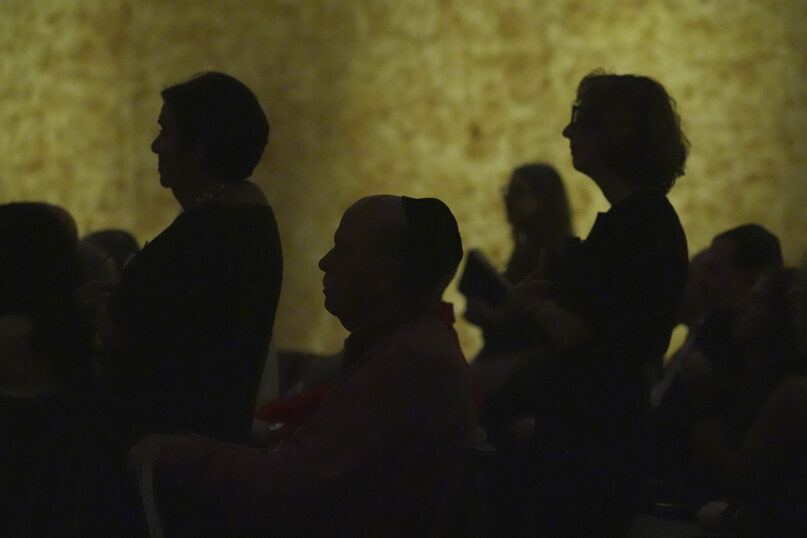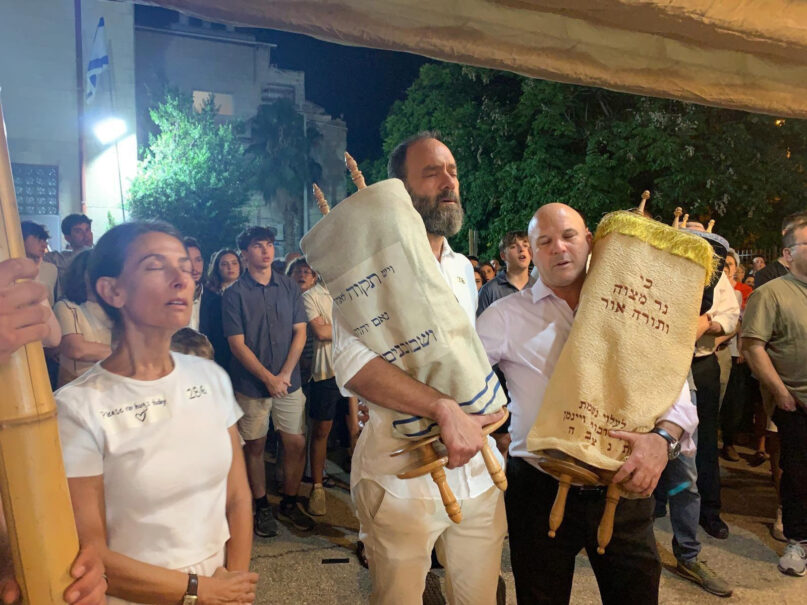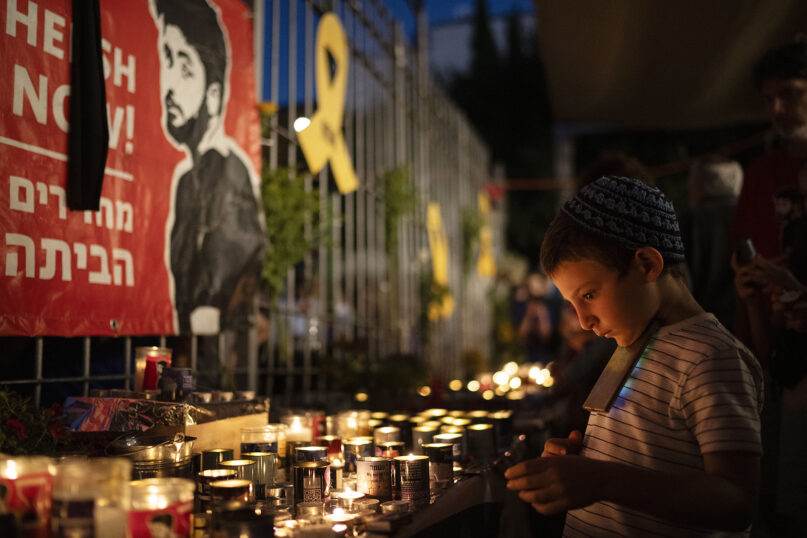
(RNS) — When you hear the blasts of the shofar, what goes through your mind and through your soul?
The sages say the blasts of the shofar should remind you of someone weeping.
That is why the Talmud calls it a day of howling, a day of weeping.
But who is weeping?
A woman.
But who is the weeping woman?
One possibility: The shofar represents the unvoiced cries of Sarah, believing her husband, Abraham, had sacrificed her son, Isaac.
So, when we blow the shofar, perhaps we hear the cries of Sarah.
But not only the cries of Sarah.
My own name for Rosh Hashana is the holiday of the weeping women.

Worshippers stand to say the names of loved ones in need of prayers during a Shabbat service, Sept. 27, 2024, at Temple Beth Sholom in Miami Beach, Fla. (AP Photo/Wilfredo Lee)
Consider the traditional Torah reading for the first day of Rosh Hashana — the story of Hagar and Ishmael.
The first Jews, Abraham and Sarah, were childless. Sarah gave her Egyptian servant girl Hagar to Abraham so he might have children through her. Hagar became pregnant, and as a result, Sarah became threatened by the servant’s presence in the household and expelled her into the wilderness.
An angel told Hagar to return to Sarah. When Hagar gave birth to her son Ishmael, Sarah again sent her out, this time with the young boy.
Hagar was afraid her son would die in the desert, and she burst into tears.
And yet, a well of water sprung forth out of the ground and the boy’s life was spared, and he went on to become the ancestor of the Arab peoples. Hagar is a weeping woman of Rosh Hashana.
In the prophetic reading for that day, we find the story of Hannah, who longs desperately for a child. She goes to the ancient sanctuary and she opens her mouth, but her cries are almost without sound. Hannah is a weeping woman of Rosh Hashana.
Then, there is the prophetic reading for the traditional second day of Rosh Hashana.
The Prophet Jeremiah responds to the destruction of Judea. The matriarch Rachel symbolizes that pain, because she had been barren for so long; because she had prayed for children; because she would give birth to Jacob’s favorite son, Joseph, and she would die giving birth to Benjamin.
Thus said the Eternal:
A voice is heard in Ramah —
Wailing, bitter weeping —
Rachel weeping for her children,
Refusing to be comforted for her children, for they are gone.
Thus said the Eternal:
Keep your voice from weeping, and your eyes from tears,
For your labor shall have its reward — declares the Eternal.
They shall return from the enemy’s land.
And there is hope for your future — declares the Eternal —
Your children shall return to their land.
Rachel is a weeping woman of Rosh Hashana.
There is one more weeping woman.

Rachel Goldberg, left in white, and her husband, Jon Polin, center, dedicate a Torah scroll in the merit of their son, Hersh Goldberg-Polin, during a Week of Goodness event in Jerusalem, July 18, 2024. (Courtesy photo)
It is Rachel Goldberg, the mother of Hersh Goldberg-Polin, of blessed memory — murdered, along with five other precious martyrs, by Hamas in Gaza. Unlike the biblical Rachel, Goldberg’s child did not “return from the enemy’s land.”
Jonathan Safran Foer writes in “Everything Is Illuminated”:
Jews have six senses. Touch, taste, sight, smell, hearing and memory. The Jew is pricked by a pin and remembers other pins. We trace the pinprick back to other pinpricks.
When Hamas murdered Hersh Goldberg-Polin, along with five other hostages, we all felt the pinpricks.
Hersh became the face of the hostages. The Goldberg-Polins became our family.
For a few minutes, Rachel Goldberg became the most famous Jew alive in the world today.
Rachel became the face of Jewish faith. We have never seen such a public display of brokenness, of pain, of hope — and faith — as we saw in Rachel.
What was the focus of Rachel’s faith?
Yes, she said beautiful words about her son’s spirit, creativity and joy.
But the world heard things from her that few people have ever heard emerging from Jewish lips.
She asked Hersh for forgiveness.
If ever I was impatient or insensitive to you during your life, or neglectful in some way, I deeply and sincerely request your forgiveness. If there was something we could have done to save you and we didn’t think of it, I beg your forgiveness. We tried so very hard. So deeply and desperately. I’m sorry.
But even more than that, she bore witness to that statement of faith — that death is not the end. She found comfort in her faith that Hersh was in the World to Come — what many people call “heaven”:
Now I no longer have to worry about you. I know you are no longer in danger. You are with beautiful Aner (who was killed on October 7) — he will show you around. You will hopefully meet my grandparents, who will adore you, and start to play chess with Papa Stan.
As we transform our hope into grief and this new unknown brand of pain, I beg of you, please do what you can to have your light shine down on me, Dada, Leebie and Orly. Help shower us with healing and resilience. Help us to rise again. I need you to do one last thing for us. I need you to help us to stay strong. And I need you to help us to survive.
We Jews have many denominations and movements; some would argue, too many.

People light candles during a vigil in memory of slain hostage Hersh Goldberg-Polin in Jerusalem, Sept. 1, 2024. (AP Photo/Leo Correa)
But there is room for one more: Goldberg-Polin Judaism — the Judaism that Rachel Goldberg and Jon Polin, Hersh’s father, demonstrated to the world.
To paraphrase Rabbi Mishael Zion:
- It would be a Judaism that has a covenant — both with God and with people of sincere faith from all religions.
- It would be a Judaism that walks in this world with faith in God and human beings.
- It would be a Judaism rooted in the weekly Torah portion and the Jewish calendar.
- It would be a Judaism that starts with Genesis, which speaks of how all people are created in the image of God.
- It would be a Judaism that continues with Deuteronomy — which says that when we enter a land we will always do “that which is good and righteous.”
- It would be a Judaism that would be equally at home in the Jewish world and in the gentile world.
I would add:
It would be a Judaism in which we hear the blasts of the shofar, and we do not only locate those blasts in the sanctuaries of our memories.
Rather, let us locate those blasts in our ability to hear the cries of women, and the cries of all people, and in the weeping buried deep within the human heart.
There was a moment in King Solomon’s life when God appeared to him.
God asked Solomon: “What shall I give you?”
What did Solomon ask of God? He asked that God give him a lev shomea — not an ear that could hear, but a heart that could hear; and a mind that could hear. A lev shomeah, a lev sh’ma – a heart that is filled with Sh’ma, with listen, with hear.
That would be my prayer for all of us, this year.
Whatever God is putting forth to us, let us listen, and let us hear.
(Adapted from my sermon on the first day of Rosh Hashana, Beit Warshawa, Warsaw, Poland)
